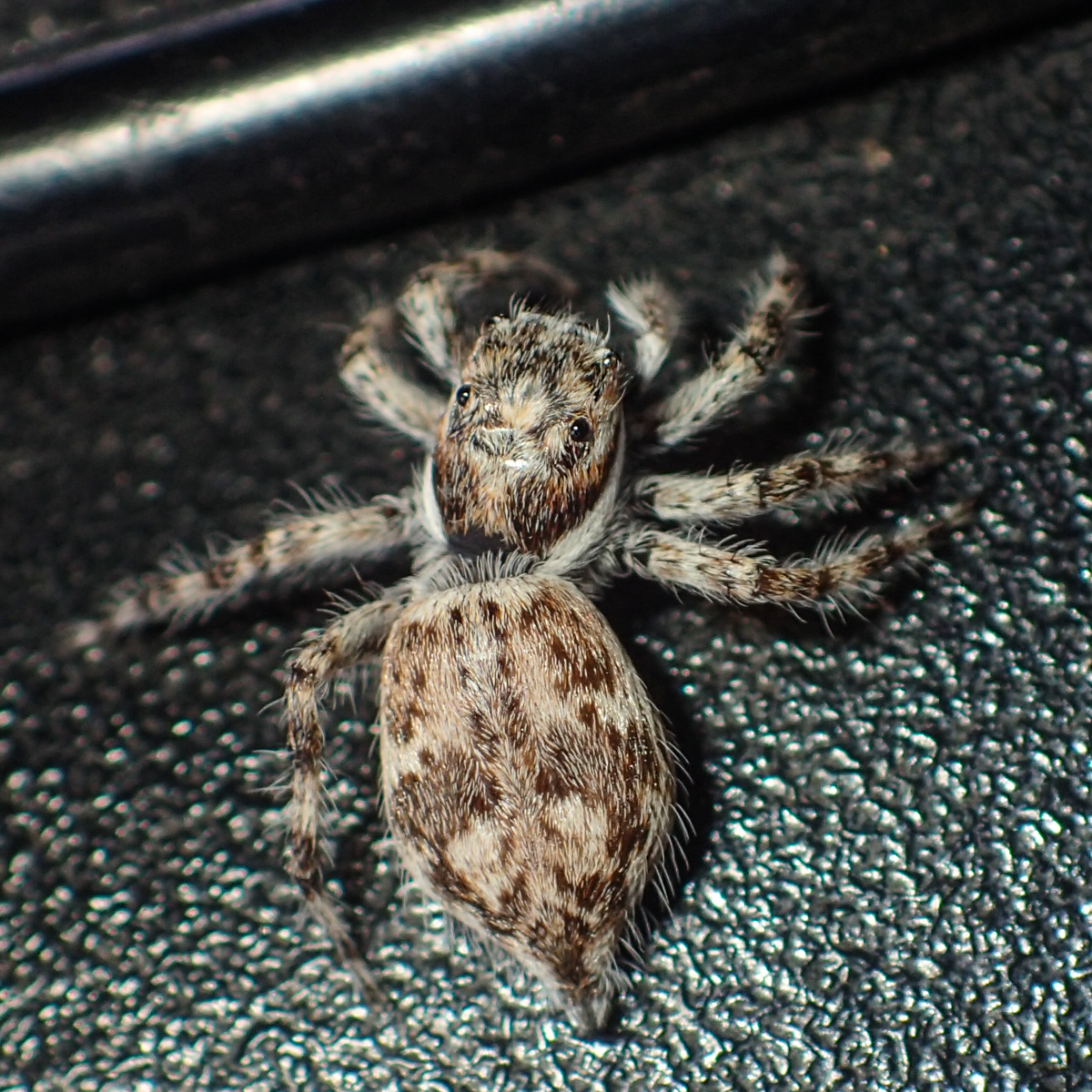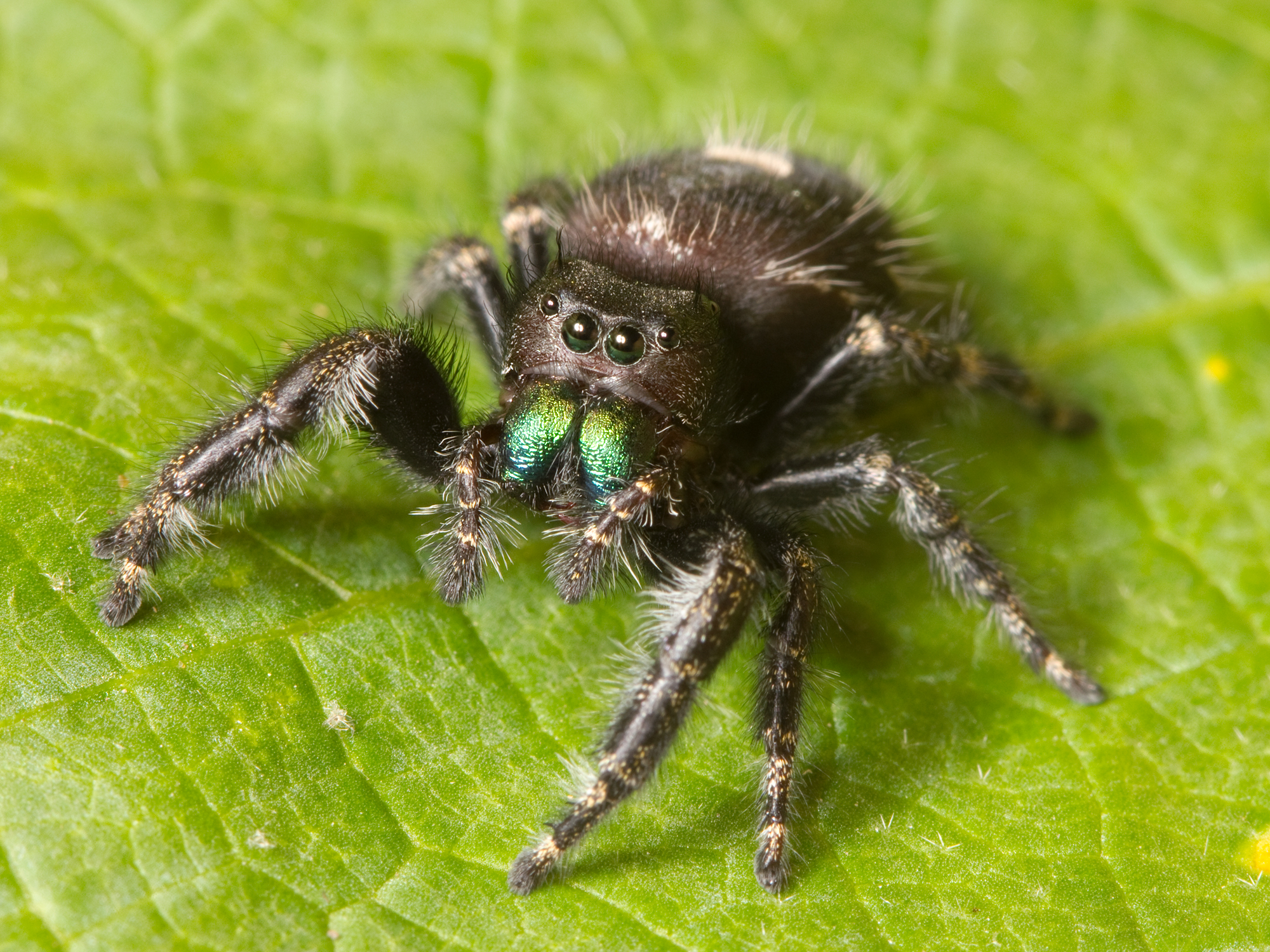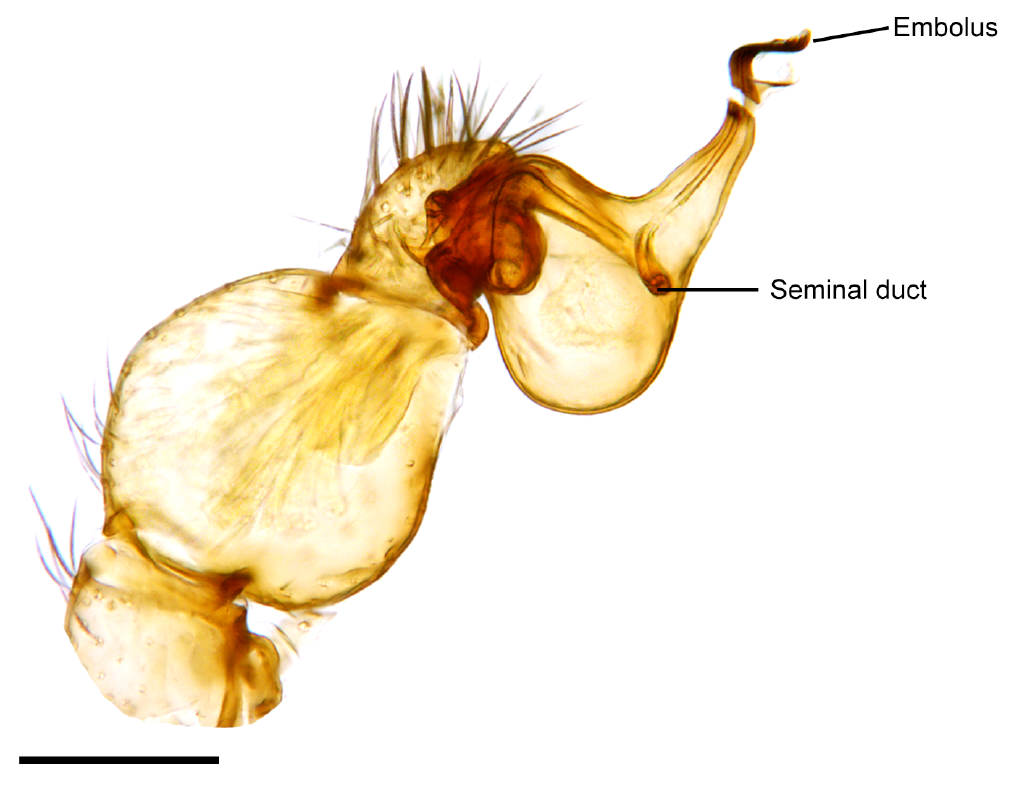|
Menemerus Nigli
''Menemerus nigli'' is a species of jumping spider in the genus ''Menemerus'' that originates in Asia. The male was identified in 2012 by Wanda Wesołowska and Mario Freudenschuss, and the female by Pir Asmat Ali, Wayne Maddison. Muhammad Zahid and Abida Buttin in 2018. The spider is medium-sized, typically in length, with a dark brown carapace and grey-brown abdomen that has a distinctive cream and white pattern created by small hairs. It was originally found in India, Pakistan and Thailand but was also found to have been introduced into Latin America, the first specimens being identified in Brazil in 2020. It seems to thrive amongst the sunlit stucco walls that are common in cities across the region. ''Menemerus nigli'' is used as an example of the ability of species that adapt to human habitation to expand their ecological niche and become global species. Taxonomy First described by Wanda Wesołowska and Mario Freudenschuss in 2012, the spider was allocated to the genus ''Men ... [...More Info...] [...Related Items...] OR: [Wikipedia] [Google] [Baidu] |
Wanda Wesołowska
Wanda Wesołowska (born 11 August 1950) is a Polish zoologist known for her work with jumping spiders. She has described more species of jumping spider than any contemporary writer, and is second only to Eugène Simon in the history of arachnology. Originally a student of ornithology, she developed an interest in jumping spiders while still a student at the Siedlce University of Natural Sciences and Humanities in the 1970s. She subsequently undertook study into the genus ''Heliophanus'' at the University of Wroclaw. Her subsequent doctoral thesis described 44 new species, and joined the staff at the university. She stayed until retiring in 2020. Her research included the taxonomy and zoogeography of jumping spiders, and has included extensive work on African genera like ''Menemerus'' and '' Pachyballus''. She has identified over 500 species, including half of all those from South Africa, as well as having more than 20 named after her. Early life Wanda Wesołowska (née Nowysz) was ... [...More Info...] [...Related Items...] OR: [Wikipedia] [Google] [Baidu] |
Phintella
''Phintella'' is a genus of jumping spiders that was first described by W. Bösenberg & Embrik Strand in 1906. Species it contains fifty-nine species and one subspecies, found in Oceania, Asia, Europe, and Africa: *'' P. abnormis'' (Bösenberg & Strand, 1906) – Russia (Far East), China, Korea, Japan *'' P. accentifera'' ( Simon, 1901) – India, China, Vietnam *'' P. aequipeiformis'' Zabka, 1985 – China, Vietnam *'' P. aequipes'' (Peckham & Peckham, 1903) – Africa **'' Phintella a. minor'' (Lessert, 1925) – East Africa *'' P. africana'' Wesolowska & Tomasiewicz, 2008 – Ethiopia *'' P. albopatella (Petrunkevitch, 1914) – Myanmar *'' P. arcuata'' Huang, Wang & Peng, 2015 – China *'' P. arenicolor'' (Grube, 1861) – Russia (Far East), China, Korea, Japan *'' P. argentea'' Kanesharatnam & Benjamin, 2019 – Sri Lanka *'' P. argenteola'' (Simon, 1903) – Vietnam *'' P. assamica'' Prószyński, 1992 – India, Laos *'' P. australis'' (Simon, 1902) – South Africa *' ... [...More Info...] [...Related Items...] OR: [Wikipedia] [Google] [Baidu] |
Fauna Of Pakistan
Pakistan 's native fauna reflect its varied climatic zones. The northern Pakistan, which includes Khyber Pakhtunkhwa and Gilgit Baltistan, has portions of two biodiversity hotspots, Mountains of Central Asia and Himalayas. Distribution Northern highlands and plains The northern highlands include lower elevation areas of Potohar and Pakistan Administered Kashmir regions and higher elevation areas embracing the foothills of Himalayan, Karakorum and Hindukush mountain ranges. Some of the wildlife species found on northern mountainous areas and Pothohar Plateau include the non-threatened mammal species of bharal, Eurasian lynx, Himalayan goral, Indian leopard, Marco Polo sheep, marmot (in Deosai National Park) and yellow-throated marten and birds species of chukar partridge, Eurasian eagle-owl, Himalayan monal and Himalayan snowcock and amphibian species of Himalayan toad and Muree Hills frog. The threatened ones include Asiatic black bear, Himalayan brown bear, Ind ... [...More Info...] [...Related Items...] OR: [Wikipedia] [Google] [Baidu] |
Arthropods Of Thailand
Arthropods (, (gen. ποδός)) are invertebrate animals with an exoskeleton, a segmented body, and paired jointed appendages. Arthropods form the phylum Arthropoda. They are distinguished by their jointed limbs and cuticle made of chitin, often mineralised with calcium carbonate. The arthropod body plan consists of segments, each with a pair of appendages. Arthropods are bilaterally symmetrical and their body possesses an external skeleton. In order to keep growing, they must go through stages of moulting, a process by which they shed their exoskeleton to reveal a new one. Some species have wings. They are an extremely diverse group, with up to 10 million species. The haemocoel, an arthropod's internal cavity, through which its haemolymph – analogue of blood – circulates, accommodates its interior organs; it has an open circulatory system. Like their exteriors, the internal organs of arthropods are generally built of repeated segments. Their nervous system is "ladder-li ... [...More Info...] [...Related Items...] OR: [Wikipedia] [Google] [Baidu] |
Rio De Janeiro
Rio de Janeiro ( , , ; literally 'River of January'), or simply Rio, is the capital of the Rio de Janeiro (state), state of the same name, Brazil's List of Brazilian states by population, third-most populous state, and the List of largest cities in Brazil, second-most populous city in Brazil, after São Paulo. Listed by the Globalization and World Cities Research Network, GaWC as a global city, beta global city, Rio de Janeiro is the Largest cities in the Americas, sixth-most populous city in the Americas. Part of the city has been designated as a World Heritage Site, named "Rio de Janeiro: Carioca Landscapes between the Mountain and the Sea", on 1 July 2012 as a Cultural Landscape. Founded in 1565 by the Portuguese people, Portuguese, the city was initially the seat of the Captaincies of the Portuguese Empire, Captaincy of Rio de Janeiro, a domain of the Portuguese Empire. In 1763, it became the capital of the State of Brazil, a List of states of the Portuguese Empire, state o ... [...More Info...] [...Related Items...] OR: [Wikipedia] [Google] [Baidu] |
Menemerus Fulvus
''Menemerus'' is a genus of jumping spiders that was first described by Eugène Louis Simon in 1868. They are long, flattened in shape, and very hairy, usually with brown and grayish hairs. Most species have white edges on the thorax. The abdomen is often oval, or sometimes elongated or rounded. Species it contains sixty-seven species, found worldwide in warmer climates. *'' M. affinis'' Wesolowska & van Harten, 2010 – United Arab Emirates *'' M. albocinctus'' Keyserling, 1890 – India (Nicobar Is.) *'' M. animatus'' O. Pickard-Cambridge, 1876 – Senegal to Iraq *'' M. arabicus'' Prószyński, 1993 – Saudi Arabia *'' M. bicolor'' Peckham & Peckham, 1896 – Guatemala *'' M. bifurcus'' Wesolowska, 1999 – Southern Africa *'' M. bivittatus'' (Dufour, 1831) – Africa. Introduced to North, Central and South America, southern Europe, China, Japan, Australia, Pacific Is., *'' M. brachygnathus'' ( Thorell, 1887) – India to Japan *'' M. brevibulbis'' (Thorell, 1887) – ... [...More Info...] [...Related Items...] OR: [Wikipedia] [Google] [Baidu] |
Species Distribution
Species distribution —or species dispersion — is the manner in which a biological taxon is spatially arranged. The geographic limits of a particular taxon's distribution is its range, often represented as shaded areas on a map. Patterns of distribution change depending on the scale at which they are viewed, from the arrangement of individuals within a small family unit, to patterns within a population, or the distribution of the entire species as a whole (range). Species distribution is not to be confused with dispersal, which is the movement of individuals away from their region of origin or from a population center of high density. Range In biology, the range of a species is the geographical area within which that species can be found. Within that range, distribution is the general structure of the species population, while dispersion is the variation in its population density. Range is often described with the following qualities: * Sometimes a distinction is made bet ... [...More Info...] [...Related Items...] OR: [Wikipedia] [Google] [Baidu] |
Chelicerae
The chelicerae () are the mouthparts of the subphylum Chelicerata, an arthropod group that includes arachnids, horseshoe crabs, and sea spiders. Commonly referred to as " jaws", chelicerae may be shaped as either articulated fangs, or similarly to pincers. Some chelicerae, such as those found on nearly all spiders, are hollow and contain (or are connected to) venom glands, and are used to inject venom into prey or a perceived threat. In '' Pisaurina mira'', also known as the nursery web spider, the chelicerae are utilized to snatch the prey once it becomes within reach, facilitating the "sit-and-wait ambush predator" behavior. Both pseudoscorpions and harvestmen have structures on their chelicerae that are used for grooming (papillae in pseudoscorpions, cheliceral teeth in Opiliones). Types Chelicerae can be divided into three kinds: jackknife chelicerae, scissor chelicerae, and 3-segmented chelate chelicerae. Jackknife chelicerae The jackknife chelicera is subchelate ... [...More Info...] [...Related Items...] OR: [Wikipedia] [Google] [Baidu] |
Pedipalp
Pedipalps (commonly shortened to palps or palpi) are the second pair of appendages of chelicerates – a group of arthropods including spiders, scorpions, horseshoe crabs, and sea spiders. The pedipalps are lateral to the chelicerae ("jaws") and anterior to the first pair of walking legs. Overview Pedipalps are composed of six segments or articles: the coxa, the trochanter, the femur, the short patella, the tibia, and the tarsus. In spiders, the coxae frequently have extensions called maxillae or gnathobases, which function as mouth parts with or without some contribution from the coxae of the anterior legs. The limbs themselves may be simple tactile organs outwardly resembling the legs, as in spiders, or chelate weapons ( pincers) of great size, as in scorpions. The pedipalps of Solifugae are covered in setae, but have not been studied in detail. Comparative studies of pedipalpal morphology may suggest that leg-like pedipalps are primitive in arachnids. At present, t ... [...More Info...] [...Related Items...] OR: [Wikipedia] [Google] [Baidu] |
Epigyne
The epigyne or epigynum is the external genital structure of female spiders. As the epigyne varies greatly in form in different species, even in closely related ones, it often provides the most distinctive characteristic for recognizing species. It consists of a small, hardened portion of the exoskeleton located on the underside of the abdomen, in front of the epigastric furrow and between the epigastric plates. Functions The primary function of the epigyne is to receive and direct the palpal organ of the male during copulation. The various specific forms of epigynes are correlated, in each case, with corresponding specific differences in the palpus of the male. This specialization prevents individuals of different species from mating. The epigyne covers or accompanies the openings of the spermathecae, which are pouches for receiving and retaining sperm. Frequently, the openings of the spermathecae are on the outer face of the epigyne and can be easily seen. A secondary funct ... [...More Info...] [...Related Items...] OR: [Wikipedia] [Google] [Baidu] |
Menemerus Zimbabwensis
''Menemerus zimbabwensis'' is a species of jumping spider in the genus ''Menemerus'' that lives in South Africa and Zimbabwe. The Polish arachnologist Wanda Wesołowska first described the female in 1999 and the male in 2007. The spider is large, with a cephalothorax that is between long and an abdomen that is between in length. The female is larger than the male. It also lacks the light stripe down the centre of its dark brown carapace and has a less distinct pattern on its abdomen. Its legs and pedipalps are yellow, while on the male they are brown. The male can be distinguished from the similar ''Menemerus nigli'' by the wide stripe on its abdomen. The female is harder to identify without looking at its copulatory organs. These are distinctive. It has characteristic large entrance bowls on its epigyne, which are larger than the insemination ducts and spermathecae combined. Its internal organs are very sclerotized. Taxonomy ''Menemerus zimbabwensis'' is a species ... [...More Info...] [...Related Items...] OR: [Wikipedia] [Google] [Baidu] |
Menemerus Pilosus
''Menemerus pilosus'' is a jumping spider species in the genus ''Menemerus ''Menemerus'' is a genus of jumping spiders that was first described by Eugène Louis Simon in 1868. They are long, flattened in shape, and very hairy, usually with brown and grayish hairs. Most species have white edges on the thorax. The abdome ...'' that lives in Namibia. The male was first described by Wanda Wesołowska in 1999. References Spiders described in 1999 Fauna of Namibia Salticidae Spiders of Africa Taxa named by Wanda Wesołowska {{Salticidae-stub ... [...More Info...] [...Related Items...] OR: [Wikipedia] [Google] [Baidu] |

.jpg)





